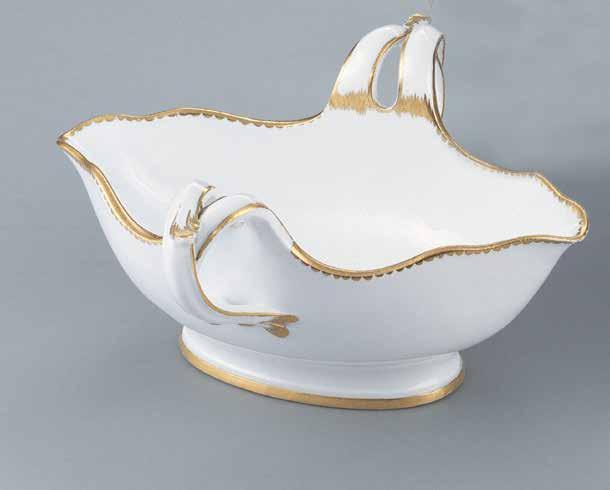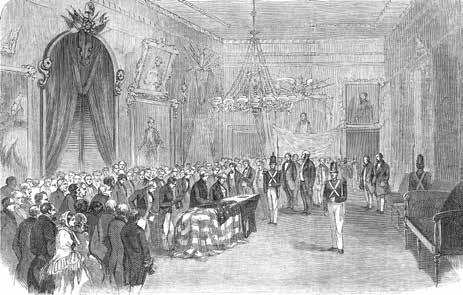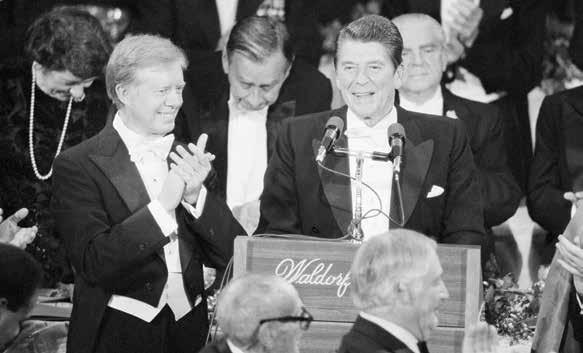
6 minute read
And a World Gone By
Outside of Washington, D.C., perhaps no city has more connections with America’s first ladies than New York. Many were born here, and others lived and worked in the city. The future first lady Nancy Davis was among those who pursued dreams here, setting out to “make it” in New York.
ANNE FRANCES (“NANCY”) ROBBINS
was born in 1921 in Flushing, Queens, to Kenneth Robbins, a used car salesman, and Edith Luckett Robbins, an actress who had performed on Broadway and wanted to return to the New York stage.1 Shortly the couple separated, and young Nancy went to live with an aunt in Bethesda, Maryland. When she returned to New York in 1944, she was Nancy Davis, now from an affluent family and who was, like her mother, an aspiring actress looking to break in to Broadway.
Nancy Robbins had had a fortunate childhood after all. In 1929 her mother married Loyal Davis, a prominent Chicago neurosurgeon, and brought her daughter back to live with them on Lake Shore Drive in Chicago. Loyal Davis adopted Nancy, and she took his name. He sent her to Girls’ Latin School and then to Smith College, where she was active in student theater productions. During summer vacations she worked in summer stock, doing “a little bit of everything,” she later recalled.2
From an early age Nancy had been star-struck by her mother’s friends, including ZaSu Pitts, Walter Huston, Spencer Tracy, and Katherine Hepburn.
They encouraged her interest in a theatrical career, and, though she returned to Chicago after college graduation, she continued to long for Broadway. She got her chance when, in 1945, ZaSu Pitts helped her land a role in a road tour of a melodramatic farce titled Ramshackle Inn, which brought her to New York. The show, which had already had a Broadway run, soon closed, but young Nancy stayed on in the city.
For ambitious young women with dreams of becoming actresses, writers, models, fashion designers, and business executives, New York was a destination, and, for single women from “good families,” the iconic Barbizon Hotel for Women was the place to live.3 This residential hotel, prestigiously located on the Upper East Side at the corner of East Sixty-Third Street and Lexington Avenue, provided young women with a feeling of sophistication, elegance, and glamour, and at the same time assured their parents of their safety and respectability. There Nancy Davis took up residence. She was in good company, for this was where many aspiring actresses and writers chose to live in New York, including over the decades previous spread left opposite Nancy Reagan (standing center) with Zazu Pitts (seated) in a performance of Ramshackle Inn 1949.
A publicity shot of actress and future first lady Nancy Davis Reagan, 1950. While pursuing her acting career in New York in the 1940s, she made her home in the Barbizon Hotel for women, illustrated here by Paul Baars.
The entrance to the Barbizon, date to come.

Lauren Bacall, Candice Bergen, Barbara Corcoran, Joan Didion, Edna Ferber, Betsey Johnson, Grace Kelly, Liza Minnelli, Sylvia Plath, Cybill Shepherd, Elaine Stritch, and “The Unsinkable” Molly Brown. The reputation and image of this women-only hotel was surely enhanced by groups that had their own separate floors, such as Powers and Ford models, Mademoiselle guests editors, and Katherine Gibbs and Wellesley College girls.
Built in 1927, the Barbizon, with its facade of salmon-colored brick, limestone, and terracotta, blended Italian Renaissance, Late Gothic Revival, and Islamic decorative elements. The stunning twenty-three floors shined high over Lexington Avenue. The hotel’s enchanting name derived from the French village of Barbizon nestled near the Fontainebleau Forest, where aspiring French artists in the nineteenth century founded the art movement known as the Barbizon School.
To be granted a reservation at this glamorous address, guests were required to submit three letters of recommendation and a promise to adhere to the rules and regulations enforced by the eagle eyes of the front desk manager and staff. Men were not allowed beyond the lobby, and the dress code was strict—business attire for the day, formal attire for the evening—and its residents were never to leave the hotel in slacks. The club-like atmosphere was one of a sorority with afternoon teas, card games, backgammon, and lecture series. But most of all, there was a sense of camaraderie among the young career-aspiring residents.
While acting in New York, Nancy Davis joined the cast of Lute Song, starring Mary Martin and Yul Brynner. Her credit line is seen near the center of the first column in the Shubert Theatre program (above left) for the production that opened in January of 1946.

Years later, First Lady Nancy Reagan welcomed Mary Martin to the White House to perform in the PBS program “A Salute to Broadway” (above right), 1988.

A regular visitor to New York throughout her life, Nancy Reagan waves at the Broadway opening of “Metamorphosis,” (left) 1989.

Like his mother, father, and grandmother, Ron Reagan pursued a career on stage. Here Nancy Reagan visits New York with her husband President Ronald Reagan to enjoy Ron Reagan’s dance performance at a Lincoln Center benefit, 1981.
In New York, Nancy Davis’s career continued to benefit from family friendships. She soon landed the role of Si-Tchun, a lady-in-waiting, in Lute Song, a musical starring Mary Martin and Yul Brynner at the Plymouth Theatre on West Forty-Fifth Street. The show ran for five months, from February to June 1946. During this time Nancy Davis mingled with Broadway stars and managers, briefly dating, most notably, Clark Gable.4 But when Spencer Tracy helped arrange a screen test for her, she won a seven-year contract with Metro-Golden-Mayer. Having briefly “made it” in New York, Nancy Davis left for California. She later exclaimed, “Joining Metro was like walking into a dream world.”5
Returning to New York in the 1980s as First Lady Nancy Reagan, the former movie star presided over A-list social events. Her close friends and confidants were the leaders of fashion, theater, and the arts. Socialites such as Betsy Bloomingdale ensured that Mrs. Reagan was in the forefront of parties and soirees.6

Meanwhile, in 1981 the Barbizon Hotel opened its doors to its first male guest, signifying the end of the glamorous women-only hotel.7 Recently restored, the building is now luxury condominiums, but it ever remains an important chapter in New York’s social history. By offering a safe haven for single young women hoping to launch successful careers, the iconic Barbizon represents a world gone by.
Notes
The epigraph is from the lyrics to “New York, New York,” most famously sung by Frank Sinatra.
1. Biographical information on Nancy Reagan’s early life is from “Biography of Nancy Reagan” and “Nancy Reagan’s Acting Career,” Ronald Reagan Presidential Library and Museum website, www. reaganlibrary.gov; James G. Benze Jr., “Nancy (Anne Frances Robbins Davis) Reagan (1921–), First Lady: 1981–1989,” in American First Ladies: Their Lives and Their Legacy, 2nd ed., ed. Lewis L. Gould (New York: Routledge, 2001), 393–94; Marc Eliot, Reagan: The Hollywood Years (New York: Harmony Books, 2008), 227–31; Dana Sauchelli and David K. Li, “Before the White House, Nancy Reagan Got Her Start in Queens,” New York Post, March 6, 2016; Jessica Contrera, “Before She Was First Lady: Nancy Reagan’s Acting Career,” Washington Post, December 3, 2021; Karen Tumulty, Triumph of Nancy Reagan (New York: Simon and Schuster, 2021). Nancy Reagan’s own account is My Turn: The Memoirs of Nancy Reagan, with William Novak (New York: Random House, 1989), 66–89. Nancy Reagan does not mention staying at the Barbizon but recalls finding “a fourth-floor walk-up” on East Fifty-First Street (p. 84).
2. Nancy Reagan, I Love You, Ronnie: The Letters of Ronald Reagan to Nancy Reagan (New York: Random House, 2000), 17.
3. Information about the Barbizon Hotel is from Tom Miller, “The 1927 Barbizon Hotel for Women—140 East 63rd Street,” posted February 25, 2012, Daytonian in Manhattan blog, www. daytonianinmanhattan.blogspot.com[?]; Nina K. Guzman, “Look Inside the Barbizon Hotel for Women: Where Sylvia Plath and Joan Didion Lived,” Bust Magazine, August¬–September 2014, online at www.bust.com; Michael Callahan, “Sorority on E. 63rd St.” Vanity Fair, April 2010, 168–75; Nicole Saraniero, “Top Ten Secrets of NYC’s Barbizon Hotel,” Untapped New York website, www.untappedcities.com; Paulina Bren, The Barbizon: The Hotel That Set Women Free (New York: Simon and Schuster, 2021).
4. Reagan, My Turn, 86–88; Eliot, Reagan, 230.
5. Reagan, My Turn, 88. See also Carl Anthony, “The Hollywood Movie Star Who Became First Lady: Nancy Reagan’s Film Career,” posted February 28, 2014, National First Ladies Library website, www.firstladies.org.
6. William Norwich, “When Nancy Reagan Ruled New York,” posted March 8, 2016, W Magazine, www.wmagazine.com.
7. Guzman, “Look Inside the Barbizon Hotel for Women.”
David please straighten and -Y from photo of letter











